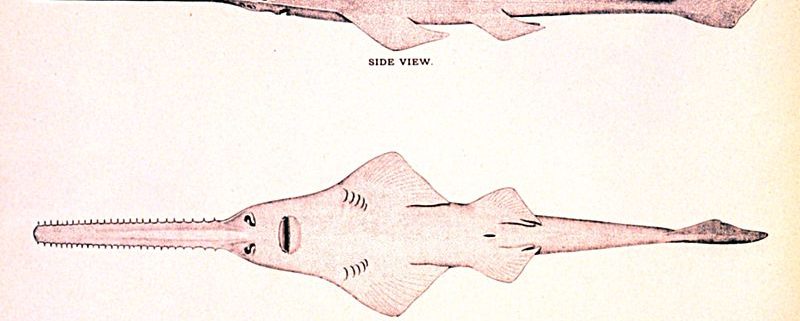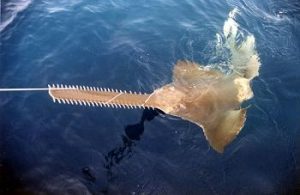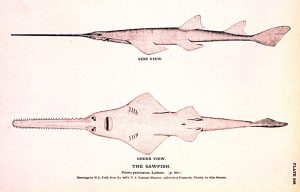An Analysis of Movement Patterns in Smalltooth Sawfish
By Laura Vander Meiden, RJD Intern
A new study by researchers at Florida State University and NOAA National Marine Fisheries assesses the habitat needs of juvenile smalltooth sawfish in an attempt to better understand what measures should be taken to protect them. Smalltooth sawfish are bottom dwelling fish very distantly related to sharks. They, and other sawfish, are characterized by their long, toothed rostrum (nose) that closely resembles a saw blade. This snout is quite prone to getting tangled in fishing gear which, in addition to habitat loss and exploitation by the global animal part trade, has led all five species of sawfish to be listed as either endangered or critically endangered. By analyzing the movements of juvenile smalltooth sawfish, this study adds to the base of knowledge needed to properly care for these species.
The study took place in three southern Florida bays, two in Everglades National Park and one in Ten Thousand Islands National Wildlife Refuge. Though the bays varied in size, all were lined with red and black mangroves and were “relatively pristine” compared to other areas in which sawfish are found. This use of optimal habitat allowed the scientists to see what juvenile sawfish behavior should look like, information that can then be used to improve less optimal habitats.
The scientists tagged seven juvenile sawfish with acoustic transmitters. These transmitters had a battery life of six months during which they would emit a signal every two to three seconds. Signals had to be actively gathered by researchers with a hydrophone and receiver; the signals didn’t automatically go into database. Overall, the researchers collected 224 hours of movement data. From this data they found that the sawfish stayed close to mangroves each individual stayed, on average, less that 100m from mangrove-fringed shoreline. The juveniles also had the highest rate of activity at night, suggesting that this was when they foraged for food. Most interestingly, they found that the size of area in which the sawfish moved directly correlated with the size of the bay, however in all cases the activity space for each individual increased day by day.
This information is important for sawfish management plans, since habitat requirements for juvenile sawfish may have been previously underestimated in studies that did not take continuous measurements of activity space. The scientists hypothesize that this increase in activity space could be due to the rapid growth of juvenile sawfish and a way to avoid competing for food with other juvenile sawfish. The fact that sawfish in larger bays had larger activity spaces while those in smaller bays had smaller activity spaces is also important. This means that one overall management plan may not be best for the sawfish. Instead management plans should be specific to each area they address.
Ultimately this study added significantly to existing information on the habitat requirements of juvenile sawfish. The results from this study can serve as a platform upon which new research and improved management plans can be built, both of which are integral in protecting smalltooth sawfish populations.
References
Hollensead, L., Grubbs, R., Carlson, J., & Bethea, D. (2015). Analysis of fine-scale daily movement patterns of juvenile Pristis pectinata within a nursery habitat. Aquatic Conservation: Marine and Freshwater Ecosystems.





Leave a Reply
Want to join the discussion?Feel free to contribute!